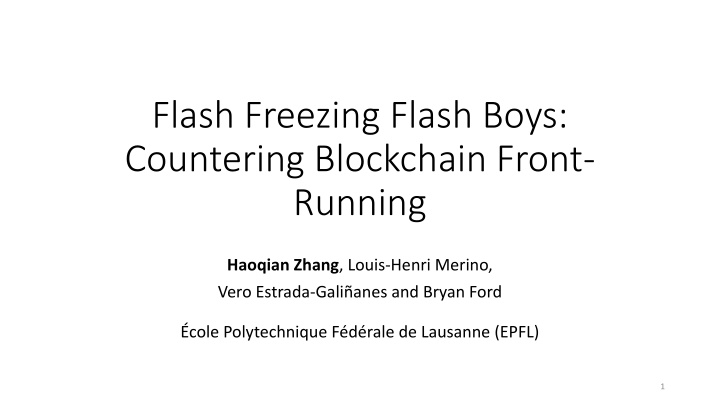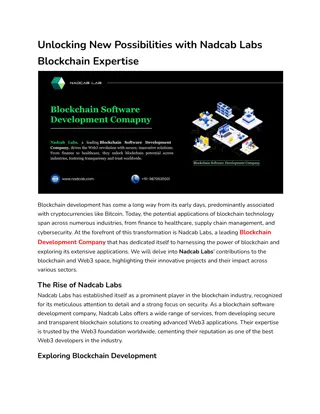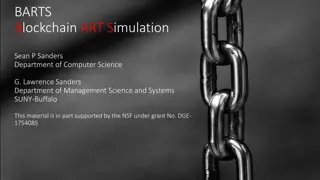Flash Freezing Flash Boys: Countering Blockchain Front-Running
Flash Freezing Flash Boys presents a detailed analysis of front-running in traditional exchanges and blockchain, showcasing various attacks like Displacement, Insertion, and Suppression. Explore the impact of front-running on transactions and learn about regulatory practices.
Download Presentation

Please find below an Image/Link to download the presentation.
The content on the website is provided AS IS for your information and personal use only. It may not be sold, licensed, or shared on other websites without obtaining consent from the author.If you encounter any issues during the download, it is possible that the publisher has removed the file from their server.
You are allowed to download the files provided on this website for personal or commercial use, subject to the condition that they are used lawfully. All files are the property of their respective owners.
The content on the website is provided AS IS for your information and personal use only. It may not be sold, licensed, or shared on other websites without obtaining consent from the author.
E N D
Presentation Transcript
Flash Freezing Flash Boys: Countering Blockchain Front- Running Haoqian Zhang, Louis-Henri Merino, Vero Estrada-Gali anes and Bryan Ford cole Polytechnique F d rale de Lausanne (EPFL) 1
Outline Front-running in Traditional Exchange Front-running in Blockchain Flash Freezing Flash Boys(F3B) Overview Experiment 2
Traditional Exchange Buy 400,000 shares Buy 400,000 shares Customer Broker Exchange 3
Front-running in Traditional Exchange Buy 20,000 shares Buy 400,000 shares Sell 20,000 shares Buy 400,000 shares Customer Broker Exchange 4
Front-running in Traditional Exchange Front running is the practice of entering into a trade to capitalize on advanced, nonpublic knowledge of a large pending transaction that will influence the price of the underlying security. Prohibited practice by regulations. 5
Blockchain Transaction Transaction Customer Blockchain Miner 7
Front-running in Blockchain Displacement Attack: Transaction Transaction Customer Blockchain Miner 8
Front-running in Blockchain Insertion Attack: Transaction Transaction Transaction Transaction Customer Blockchain Miner 9
Front-running in Blockchain Suppression Attack: Transaction Transaction Customer Blockchain Miner 10
Front-running in Blockchain A front-running attack is a practice where an entity benefits from early access to some pending transactions. No regulation. Front-running attacks cause a loss of 280M each month worldwide*. * https://cybernews.com/crypto/flash-boys-2-0-front-runners-draining-280-million-per-month-from-crypto-transactions/ 11
Strawman: Commit-and-Reveal by User Tx: Tx: Value so that Hash(Value) = Commit Commit Drawbacks: (1) Two transactions (2) Suppression Attack possible 12
Transaction Commitment Execution Time Commitment Time m block confirmations Time: Time: 13
F3B: Supporting encrypted transactions* Execution Time Commitment Time m block confirmations Time: Time: * Requires the modification at the blockchain architecture layer. 14
How does F3B mitigate front-running A front-running attack is a practice where an entity benefits from early access to some pending transactions. Reasoning from definition: transactions are encrypted before commitment -> attackers can not benefit from pending transactions. 15
Architecture Overview Senders Secret-management committee (2) Release keys after commitment (1) Publish encrypted transactions Consensus Group 16
Protocol 17
Protocol 18
Protocol 19
Latency* Ethereum Block Time = 13s Block confirmations = 20 => Latency = 260s F3B with 128 nodes Latency 1.77s 0.68% latency overhead in Ethereum * We ran our experiment on a server with 32GB of memory and 40 CPU cores running at 2.1GHz. 20
Throughput* Ethereum Around 15tps F3B with 128 nodes 13.2tps Latency 9.7 seconds 3.7% latency overhead in Ethereum * We ran our experiment on a server with 32GB of memory and 40 CPU cores running at 2.1GHz. 21
Conclusion Front-running is a big issue in blockchain/DeFi Mitigates front-running attacks Requires modification of blockchain architecture Presents low latency overhead 22























